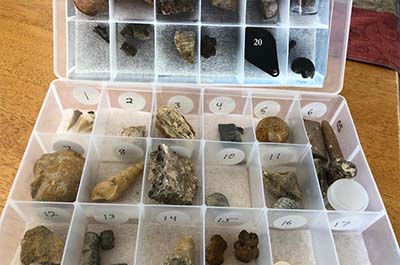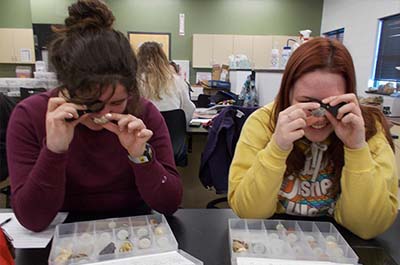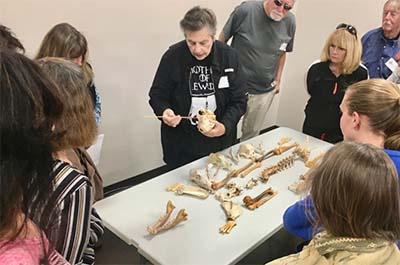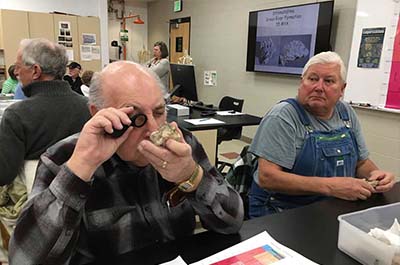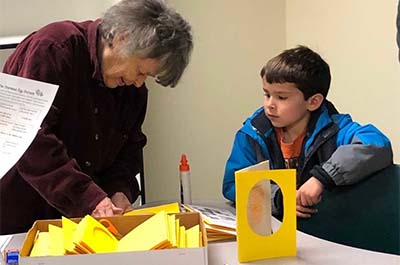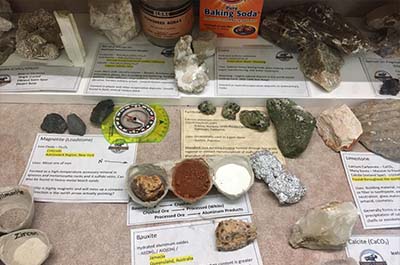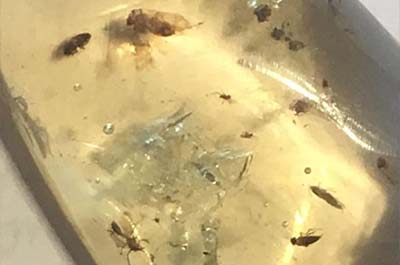Introducing Geology Students to Fossils
How does Steve Wolfe, Historical Geology instructor at PCC-Fremont Campus, prepare his students for field season observations? One way is by introducing them to fossils: fossils found locally and fossils that can aid in identification and dating certain sedimentary layers (biostratigraphy).
We presented Fossil Boot Camp to 24 of his students, most with no previous understanding of nor interest in paleontology. These students were introduced to crinoids, ammonites, trilobites and baculites, and 12 other fossils.
They learned how to tell the difference between clams and brachipods, and what Mary Anning did with a 180 million year old ink sack from a belemnite. (She drew a picture of a belemnite.)
Instructor Steve Wolfe with a gorgeous chunk of colonial coral.
Sometimes petrified wood and dinosaur bone look a lot alike. Harold Taylor explained how to see the cellular structure of bone for positive identification.
Fossil trilobites from Oklahoma and Morocco, located 4,000 miles apart today, look almost exactly alike. What can that tell paleontologists and geologists? That 450 million years ago these locations shared the same continental shelf, helping scientists determine the location of the continental plates at that time and their subsequent movements involved in our planet’s intricate plate tectonics.
How long does it take wood to petrify? It all depends on the environment, location, and deposition. Harold gave some fascinating details of 15 million year old wood that is still wood and 13 year old wood that has already begun to petrify.
The session ended with a few words about legal fossil collecting and responsible collecting. Some questions went unanswered – the opportunity for a bit of individual research. We enjoyed the opportunity to share our passion for fossils with a group of geology enthusiasts, and perhaps play a role in their appreciation for the richness beneath our feet that surrounds our community.
Presenter Harold Taylor with the PCC Historical Geology students
More Articles from “Stones ‘n’ Bones Activities”
Fossil Boot Camp – Covid Style
Stones ‘n Bones of Fremont County traditionally presents two or three Fossil Boot Camp classes each year for school age students and adults. With COVID, that has proven a little difficult
Fossil Boot Camp for PCC Historical Geology Students
Fremont Stones ‘n Bones introduced 16 Pueblo Community College students to fossils in Steve Wolfe’s Historical Geology class.
Stones ‘n’ Bones With Villa Bella School’s 2nd Graders
“What do paleontologists do?” is the question we were asked to help answer for 50 second graders at Pueblo, Colorado’s newest elementary school on January 16, 2020.
The Close Relationship Between Man & Dog
Dr. Sue Ware returned to the Royal Gorge Dinosaur Experience for the second time, to the delight of 27 community members. She presented a program entitled “From your Campfire to your Bed: The Evolution, Importance & Relationship between Dogs and Humans”.
Fossil Boot Camp at PCC Mini-College
For the 5th straight year, Stones ‘n Bones presented Fossil Boot Camp to 31 senior citizens in the Fremont County community.
Stones ‘n’ Bones & the Enormous Egg
What happens when an entire elementary school reads the same book, The Enormous Egg, and asks Fremont County Stones and Bones to come in to help with the family night to celebrate the reading? A two-hour evening full of paleontology learning!
Introducing Geology Students to Fossils
How does Steve Wolfe, Historical Geology instructor at PCC-Fremont Campus, prepare his students for field season observations? One way is by introducing them to fossils
Identifying Trilobites
The Pioche Formation of eastern Nevada is world famous for its amazing preservation of trilobites. Very old trilobites, from the Lower Cambrian (542 – 521 million years old), almost the oldest on record.
Everything Begins With Mining
There are many ways to appreciate rocks. Many of us notice them simply for their color, texture and shape, irresistible and raw in nature.
Insects Trapped in Amber
Many of us are familiar with the high preservation of insects and leaves in the Green River Formation, a Colorado lagerstätte well known for field trips yielding magnificent fossils.

